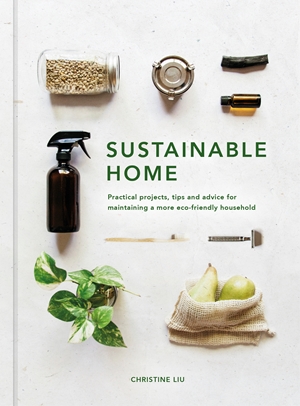Eco-friendly laundry tips
Small changes can make a big difference for being more resource-efficient. These eco-friendly laundry tips will help you with laundering clothes with less carbon impact. This is an excerpt from Sustainable Home by Christine Liu.
Resource-efficient and eco-conscious laundering

Some simple changes can be made to lessen the overall impact of laundering, while still keeping your clothes clean. An average household will go through roughly 400 loads of laundry each year, using 13,500 gallons of water in the process. It is estimated that 75 per cent of our clothing’s carbon impact comes from washing and drying.
Knowing when clothing should actually be washed can help reduce the frequency of laundering, and also increase the lifespan of your beloved clothing pieces:
- All undergarments and activewear should be washed after one wearing, as these pieces are close to the skin and sweat, an ideal spot for bacteria. All other garments that can be worn again should hang in
open air to allow the fabric to relax and freshen. - Tops, t-shirts, and blouses can be washed after a few
wears if they don’t smell, and sleepwear every two to threewears since we typically sweat more at night. - Jeans and office wear can be washed after four to five
wears , especially if you find yourself sitting in an office for the majority of the day without much physical activity. - Chunky sweaters and jackets that are not always directly touching the skin can be washed every six
wears . - Remember that delicates such as silks, lighter knits made of cashmere and thinner clothing pieces are good candidates for hand-washing. Though dry cleaning is a common option for delicate clothing, dry cleaning is notorious for using chemicals such as perchloroethylene which has several dangerous health effects, so look for green dry cleaners when possible or handwash if you can, and air dry these delicate pieces.
Once it’s time to launder your clothing, make sure that you are able to run a full load. Each household could save 99 pounds of carbon dioxide emissions annually if only full loads of laundry were done. In addition, 90 per cent of the energy used to wash clothing in a traditional washing machine comes simply from heating water, whereas the other 10 comes from running the motor. So when possible, use cold water to wash your clothing – it’ll save you money, and increase the overall longevity of your pieces (cold water is much more gentle).

Common laundry detergents on the market today contain synthetic chemicals that are harmful not only to us, but also to aquatic species (once they’ve made their way into our local water systems). Instead, look for eco- friendly detergents that are phosphate free, biodegradable, and made from plant-based ingredients. You can also make your own washing soda or use soap nuts (berry shells which naturally contain a soap called saponin) as a homemade option, but note that these homemade solutions are not as suitable if your house has hard water, which is dense in mineral content and more difficult to wash with. If you also use fabric softener, a cup of white vinegar is a great alternative to add during the rinse cycle. Vinegar balances out the pH of total soap and water solution to leave your fabrics softer. There should be no smell as long as it is rinsed properly.
Air-dry all clothing when possible, whether it’s with a clothing rack or a DIY string hung up in the backyard. Your household will save 700 pounds of carbon emissions from hand drying your laundry instead of using a drying machine. Direct sunlight can ward off bacteria and also help freshen your clothing. If air drying is not possible, laundering on low heat is best to save energy. Instead of using synthetic dryer sheets to freshen your clothing, you can opt for wool dryer balls as an alternative, and add a few drops of your

This, “Resource-efficient and eco-conscious laundering,” is excerpted from Sustainable Home by Christine Liu. Used with permission of the publisher, White Lion Publishing (Quarto).

Thanks for this! I’ve also noticed that the sun sometimes removes stains that didn’t come out in the washing. I got Easter lily pollen on a shirt once and was sorry to see it still there after the wash but then was happy to see it was gone after hanging in the sun. I have noticed it other times with other substances too. I also enjoy the excuse to be outside for a few minutes, even in the winter when it all freezes solid. It still dries, though may take a couple days, and I sometimes see or hear an interesting bird or other natural phenomena that I wouldn’t have otherwise. It isn’t that I don’t get outside a lot, because I do, but I do get involved in some inside activity and forget to go outside, and hanging the laundry out solves that problem!